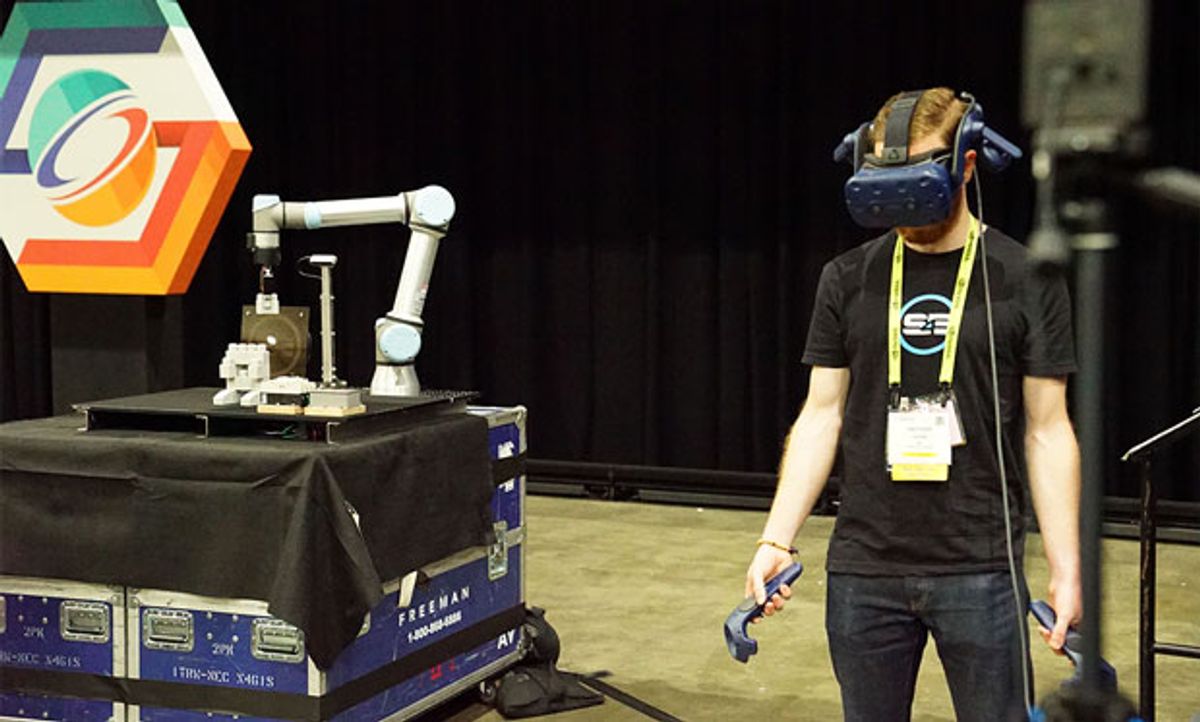Pavel Savkin remembers the first time he watched a robot imitate his movements. Minutes earlier, the engineer had finished “showing” the robotic excavator its new goal by directing its movements manually. Now, running on software Savkin helped design, the robot was reproducing his movements, gesture for gesture. “It was like there was something alive in there—but I knew it was me,” he said.
Savkin is the CTO of SE4, a robotics software project that styles itself the “driver” of a fleet of robots that will eventually build human colonies in space. For now, SE4 is focused on creating software that can help developers communicate with robots, rather than on building hardware of its own.
The Tokyo-based startup showed off an industrial arm from Universal Robots that was running SE4’s proprietary software at SIGGRAPH in July. SE4’s demonstration at the Los Angeles innovation conference drew the company’s largest audience yet. The robot, nicknamed Squeezie, stacked real blocks as directed by SE4 research engineer Nathan Quinn, who wore a VR headset and used handheld controls to “show” Squeezie what to do.
As Quinn manipulated blocks in a virtual 3D space, the software learned a set of ordered instructions to be carried out in the real world. That order is essential for remote operations, says Quinn. To build remotely, developers need a way to communicate instructions to robotic builders on location. In the age of digital construction and industrial robotics, giving a computer a blueprint for what to build is a well-explored art. But operating on a distant object—especially under conditions that humans haven’t experienced themselves—presents challenges that only real-time communication with operators can solve.
The problem is that, in an unpredictable setting, even simple tasks require not only instruction from an operator, but constant feedback from the changing environment. Five years ago, the Swedish fiber network provider umea.net (part of the private Umeå Energy utility) took advantage of the virtual reality boom to promote its high-speed connections with the help of a viral video titled “Living with Lag: An Oculus Rift Experiment.” The video is still circulated in VR and gaming circles.
In the experiment, volunteers donned headgear that replaced their real-time biological senses of sight and sound with camera and audio feeds of their surroundings—both set at a 3-second delay. Thus equipped, volunteers attempt to complete everyday tasks like playing ping-pong, dancing, cooking, and walking on a beach, with decidedly slapstick results.
At outer-orbit intervals, including SE4’s dream of construction projects on Mars, the limiting factor in communication speed is not an artificial delay, but the laws of physics. The shifting relative positions of Earth and Mars mean that communications between the planets—even at the speed of light—can take anywhere from 3 to 22 minutes.
A long-distance relationship
Imagine trying to manage a construction project from across an ocean without the benefit of intelligent workers: sending a ship to an unknown world with a construction crew and blueprints for a log cabin, and four months later receiving a letter back asking how to cut down a tree. The parallel problem in long-distance construction with robots, according to SE4 CEO Lochlainn Wilson, is that automation relies on predictability. “Every robot in an industrial setting today is expecting a controlled environment.”
Platforms for applying AR and VR systems to teach tasks to artificial intelligences, as SE4 does, are already proliferating in manufacturing, healthcare, and defense. But all of the related communications systems are bound by physics and, specifically, the speed of light.
The same fundamental limitation applies in space. “Our communications are light-based, whether they’re radio or optical,” says Laura Seward Forczyk, a planetary scientist and consultant for space startups. “If you’re going to Mars and you want to communicate with your robot or spacecraft there, you need to have it act semi- or mostly-independently so that it can operate without commands from Earth.”
Semantic control
That’s exactly what SE4 aims to do. By teaching robots to group micro-movements into logical units—like all the steps to building a tower of blocks—the Tokyo-based startup lets robots make simple relational judgments that would allow them to receive a full set of instruction modules at once and carry them out in order. This sidesteps the latency issue in real-time bilateral communications that could hamstring a project or at least make progress excruciatingly slow.
The key to the platform, says Wilson, is the team’s proprietary operating software, “Semantic Control.” Just as in linguistics and philosophy, “semantics” refers to meaning itself, and meaning is the key to a robot’s ability to make even the smallest decisions on its own. “A robot can scan its environment and give [raw data] to us, but it can’t necessarily identify the objects around it and what they mean,” says Wilson.
That’s where human intelligence comes in. As part of the demonstration phase, the human operator of an SE4-controlled machine “annotates” each object in the robot’s vicinity with meaning. By labeling objects in the VR space with useful information—like which objects are building material and which are rocks—the operator helps the robot make sense of its real 3D environment before the building begins.
Giving robots the tools to deal with a changing environment is an important step toward allowing the AI to be truly independent, but it’s only an initial step. “We’re not letting it do absolutely everything,” said Quinn. “Our robot is good at moving an object from point A to point B, but it doesn’t know the overall plan.” Wilson adds that delegating environmental awareness and raw mechanical power to separate agents is the optimal relationship for a mixed human-robot construction team; it “lets humans do what they’re good at, while robots do what they do best.”
This story was updated on 4 September 2019.



